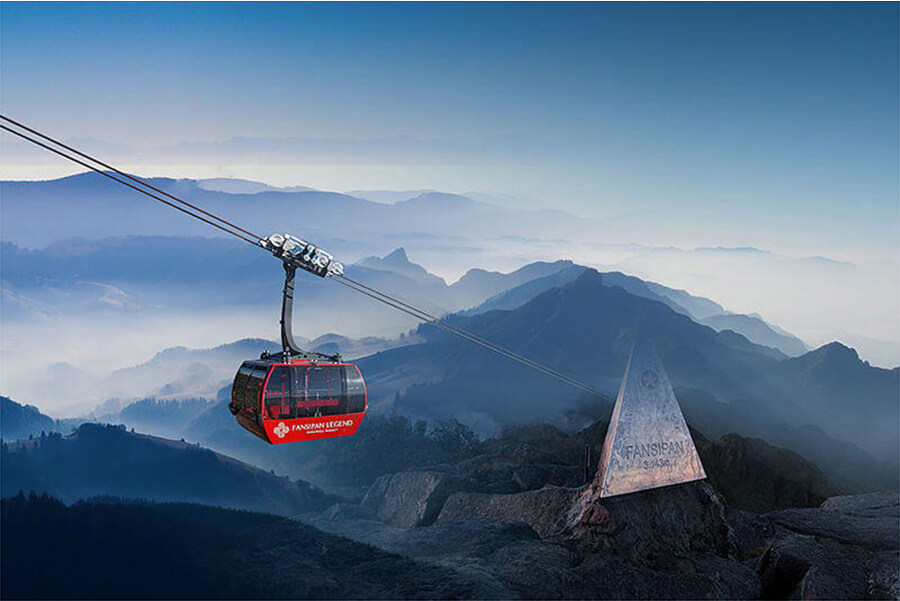Perched at an awe-inspiring elevation of 3,147 meters, Mount Fansipan reigns as the pinnacle of the Indochinese Peninsula. This monumental peak, often dubbed the “Roof of Indochina,” exudes an allure that transcends its physical height. While many mountaineers may relish the challenge of summiting such a majestic edifice via arduous trekking routes, an alternative exists—a cable car that whiskers visitors to the summit, enveloped in panoramic vistas and serene landscapes.
The journey begins in the charming town of Sa Pa, an inviting locale known for its terraced rice fields and vibrant local cultures. As you set foot in the region, a wave of tranquility washes over you, infused by the crisp mountain air and the harmonious blend of nature and human endeavor. The anticipation builds, and with each passing moment, the promise of adventure lingers in the atmosphere.
At the base of Mount Fansipan, the cable car station stands as a modern marvel, juxtaposed against the ancient backdrop of the mountain. This striking contrast piques curiosity—how can such contemporary technology coexist with nature’s profound beauty? The cable car itself is a testament to human innovation, designed not only to transport but to offer an experience that is nothing short of breathtaking.
As you step into the gleaming cabin, the doors glide shut, and you feel a gentle lurch upward. Within moments, the world beneath you begins to recede, revealing the patchwork quilt of lush valleys and rolling hills that characterize the region. The ascent is not merely a means to an end but a journey of discovery. You’ll have the rare opportunity to witness the expansive Muong Hoa Valley peppered with farming activities and the enchanting terraced rice fields that seem to cascade down the mountainsides.
During the ride, a sense of euphoria envelops passengers. You become acutely aware of your surroundings; a tapestry of greens, browns, and the occasional burst of vibrant color play out beneath you. The cable car, capable of accommodating up to 30 people, soars across a landscape that transforms with every passing moment. Towering conifers and dense, mist-laden forests punctuate the ascent, wrapping the ride in an embrace of undulating greenery.
The cable car itself is impressive; it holds the Guinness World Record for the longest non-stop three-rope cable car stretch at nearly 6,300 meters. The engineering feat is a marvel, but even more captivating is the perspective it provides. It allows travelers who might not typically attempt a strenuous hike to commune intimately with the mountain and appreciate its grandeur.
As the summit nears, the anticipation builds to a crescendo. Upon disembarkation, you find yourself enveloped in an otherworldly atmosphere, where the clouds dance around you, and the peaks of the Hoàng Liên Son mountains stretch towards the horizon. Whether it’s draped in mist or basking under abundant sunlight, the summit of Fansipan is testament to nature’s dramatic flair. Here, everything seems monumental—every crag, every peak a silent testament to the Earth’s geological history.
At the summit, an impressive bronze statue of the Buddha stands watch over visitors, welcoming a range of pilgrims and adventurers alike. The spiritual energy here is palpable. Many take a moment for reflection, contemplating their journey and the broader significance of nature and personal challenges. History, geography, and spirituality meld harmoniously in this sacred space, rendering each visit a unique and transformative encounter.
The narrative of Mount Fansipan also weaves in cultural threads, drawing from the rich history of the local ethnic communities that have inhabited the area for centuries. Their relationships with the mountain are steeped in myth and reverence, as they see Fansipan not just as a geographic feature, but as a sacred guardian. These cultural insights deepen visitors’ appreciation for the experience, bridging the gap between the natural and the cultural.
Descending via the cable car, many find themselves intertwined in contemplative thought about their own challenges and triumphs. The transition from summit to base is more than a simple descent; it is a reconnection with the world that waits below. As the cable car glides back down, one can reflect on the meanings expressed through natural beauty and personal ambitions, a journey that resonates at a profound level.
Returning to Sa Pa, the vibrant local markets await, brimming with textiles, handicrafts, and the rich aroma of traditional cuisine. It’s an invitation to linger a bit longer, to indulge in the flavors that define the region and engage with the locals who carry the wisdom of the mountains in their stories. This additional excursion reinforces the cyclical nature of exploration—the journey does not end at the peak, but rather expands into deeper connections with the landscape and its people.
Furthermore, the cable car to Fansipan epitomizes the harmonious relationship between modernity and tradition. It provides access to awe-inspiring landscapes while fostering a sense of responsibility for preserving these natural wonders for generations to come. Visiting this breathtaking destination reminds one of the intrinsic bond humanity shares with nature, elucidating the deeper reasons for our fascination with mountainous terrains.
In conclusion, the cable car journey to the summit of Mount Fansipan offers more than just a breathtaking view; it presents a unique fusion of adventure, reflection, and cultural enrichment. Whether you seek solitude, exhilaration, or connection with others, this experience is bound to linger in your heart and mind long after your descent. You don’t merely behold the Roof of Indochina; you encounter a microcosm of the human spirit—a brief, shining moment where the heights of nature invite you to hope, dream, and aspire.
